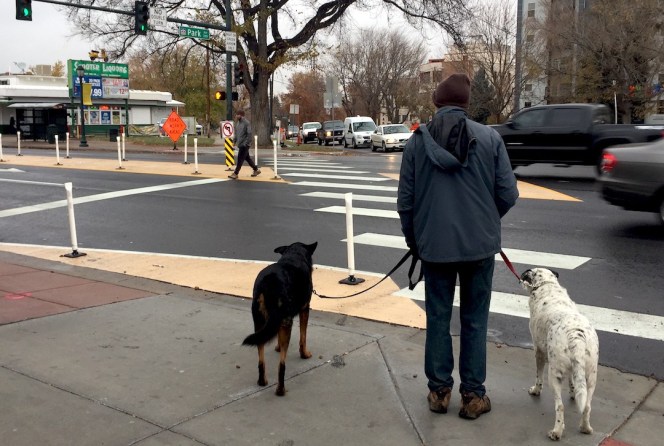New Regional Vision Zero Plan Will Encourage Street Safety Beyond Denver & Boulder

What number of traffic deaths is an acceptable goal within the Denver Metro? A new video poses that question to people on the street. The next question follows up on the idea — with a twist.
“What should the goal be for your family?”
Everyone responded with one word.
“Zero.”
The video is helping the Denver Regional Council of Governments kick off a new region-wide Vision Zero program to help cities and counties within the Denver Metro improve street safety.
“I love the video,” said Jill Locantore of the Denver Streets Partnership. “It makes a strong case that zero is the right goal for the number of traffic fatalities. That’s the starting point that should inform the rest of the plan.”
Traffic fatalities and injuries are rising fast. In the Denver Metro. The number of people who died in traffic crashes reached 266 in 2017, according to the DRCOG-CDOT Crash Database. In Denver, traffic fatalities are up 52 percent so far this year, according to the Denver Police Department. The rising deaths pushed DRCOG to step up its street safety efforts.
“We’ve had clear direction from our board to do whatever we can to help the region make headway on this safety issue,” said Jacob Riger, a transportation planner with DRCOG.
When the the agency puts forward its plan sometime next year, it will join the Portland and Tampa Metros to be among the first to adopt Vision Zero plans at the regional level. Until then, Riger encourages residents to weigh in, which is possible through an online survey and an online map where people can call out specific places where safety concerns exist.
Locantore says the Vision Zero plan could go a long way toward reducing traffic injuries and fatalities beyond Denver, in part because DRCOG helps to allocate funding for streets and highway improvements.
“It could have a huge impact,” she said. “Traffic fatalities don’t stop at the border of Denver. “
In recent years, Denver and Boulder have made Vision Zero pledges to end all traffic fatalities and serious injuries, but none of the 54 other cities, towns and counties in the region have followed.
“The more the Denver Metro area is committed to the goals of Vision Zero, the more effective they’re all going to be,” she said.
Many smaller jurisdictions have not dedicated the staff or money to launch their own programs, but DRCOG wants to offer a toolkit to help them create safer streets.
“In our regional Vision Zero plan, we want to provide a common regional set of tools and resources,” said Riger. “If they’re a smaller government that may not have the resources of Denver, our regional Vision Zero plan will provide them with the data analysis and strategies they can take and run with in their community.”
He cited the paint and plastic posts Denver installed at East Colfax Avenue where it meets Park Avenue and Franklin Street as an example other municipalities could follow. There, Denver created pedestrian islands and curb extensions to narrow the street, slow traffic, and make it safer for people to cross the street.
“Denver has been a key stakeholder with us,” said Riger. “They’re learning lessons as they implement their Vision Zero program. We’re trying to learn from them.”
Before municipalities take action at a dangerous place, like on Colfax, they first study crash data and consider a range of safety upgrades, including changing traffic signal timing, improving crosswalks or adding bike lanes. Under the new program, DRCOG will collect and offer such information.
The agency will also set up a high-injury network across the region. Denver’s high-injury network represents the five percent of city streets where more than half of all serious injuries and fatalities occur.
“Like Denver and other high-injury networks, you’re looking to find the greatest return on investment for the greatest number of injuries, so you can focus resources,” said Riger. “We’re not trying to reinvent the wheel here, but we are trying to scale it up for the region.”
Support the nonprofit mission of Streetsblog Denver. Give $5 per month.


